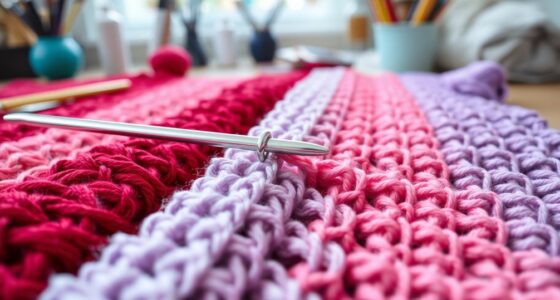In crochet, "SK" means to skip stitches. This technique's vital for creating open spaces and lacy designs, which can enhance your projects' beauty. It also plays an important role in crafting buttonholes, allowing for customization based on button size. Mastering the SK technique opens up new design possibilities and encourages creativity. So, if you're enthusiastic to explore more about its applications and tips, you'll want to keep going!
Key Takeaways
- "SK" stands for "skip," a technique in crochet that involves omitting specified stitches in a pattern.
- This technique is crucial for creating open, lacy designs and enhancing the aesthetic appeal of projects.
- Skipping stitches allows for the creation of functional buttonholes, adjusting size without adding bulk.
- The SK technique encourages creativity, enabling crocheters to experiment with various textures and intricate designs.
- Using stitch markers and regular counting is essential for accurate execution of the SK technique and maintaining project alignment.
Understanding SK in Crochet
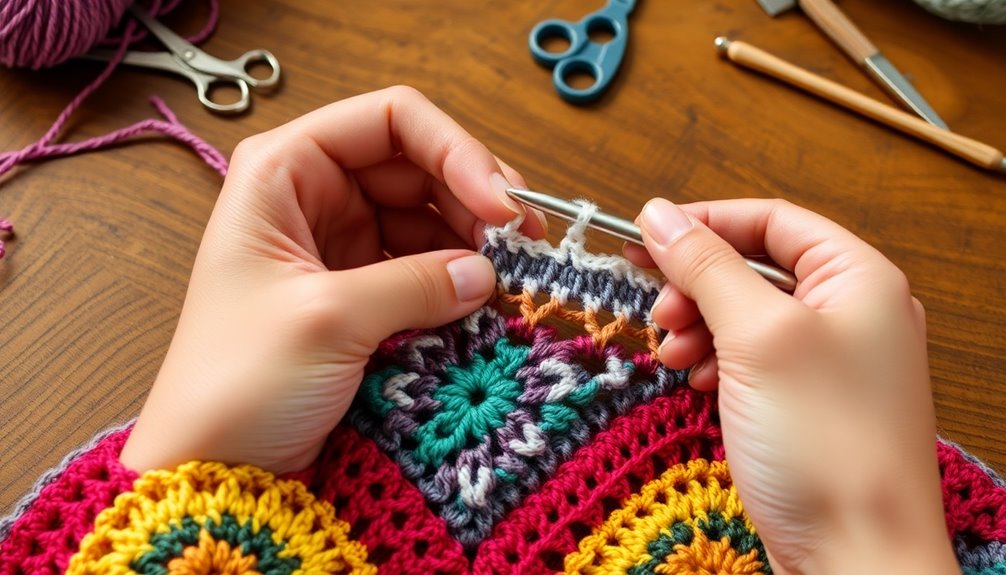
When you see "SK" in a crochet pattern, it means you should skip a certain number of stitches. This simple instruction is crucial for creating various textures and designs, such as lacy patterns or buttonholes.
By mastering the technique of skipping stitches, you can shape your fabric and adjust stitch counts without adding unnecessary bulk, which is particularly useful in garment construction.
Incorporating "SK" allows you to enhance your creativity and achieve more intricate crochet patterns. To help execute these instructions accurately, consider using stitch markers. They can keep your stitch counts organized and prevent misalignment in your work.
Embracing the "SK" technique is an essential skill for crocheters at all levels.
What Does SK Mean in Crochet?

In crochet patterns, "SK" is an essential instruction that tells you to skip a specific number of stitches. This means you won't be working into those stitches, allowing you to create open spaces or lacy designs that enhance your project's aesthetic appeal.
Mastering the SK technique is vital for both beginners and advanced crocheters, as it can shape items like buttonholes or adjust the fit of garments. When you understand how to execute SK correctly, it opens up a world of creativity and versatility in your crochet patterns.
You can experiment with varied textures and designs, making your work truly unique. So, next time you see "SK," you'll know it's your cue to skip those stitches!
Uses of Skip in Crochet

When you skip stitches in crochet, you create beautiful lacy designs that really enhance your projects.
This technique is also great for making functional buttonholes, ensuring your garments are both stylish and practical.
Understanding how to use skips effectively will elevate your crochet skills and open up new design possibilities.
Creating Lacy Designs
Skipping stitches, often noted as "sk" in crochet patterns, is a fundamental technique that opens up a world of lacy designs. By mastering this method, you can create airy and delicate patterns that enhance the beauty of your projects. Think of how satisfying it is to see the intricate details come to life!
| Lacy Design | Effect | Example Patterns |
|---|---|---|
| V Stitches | Introduces holes | Shawls, Scarves |
| Shells | Adds texture | Blankets, Tops |
| Openwork Motifs | Creates flow | Doilies, Bags |
| Mesh Patterns | Lightweight feel | Summer Garments |
| Lace Panels | Elegant touch | Evening Wear |
With "sk," you're on your way to crafting stunning pieces!
Functional Buttonholes Making
Mastering the skip technique not only enhances your ability to create lacy designs but also plays an essential role in crafting functional buttonholes.
Understanding how to use "sk" effectively can transform your crochet projects. Here's how to get started:
- Choose your button size: Determine the size of the button to decide how many stitches to skip.
- Chain the right amount: Start by chaining a specific number of stitches to create the buttonhole's foundation.
- Skip stitches accurately: Guarantee you skip the correct stitches to form an opening that aligns perfectly with your button.
As a Lacy Design Element
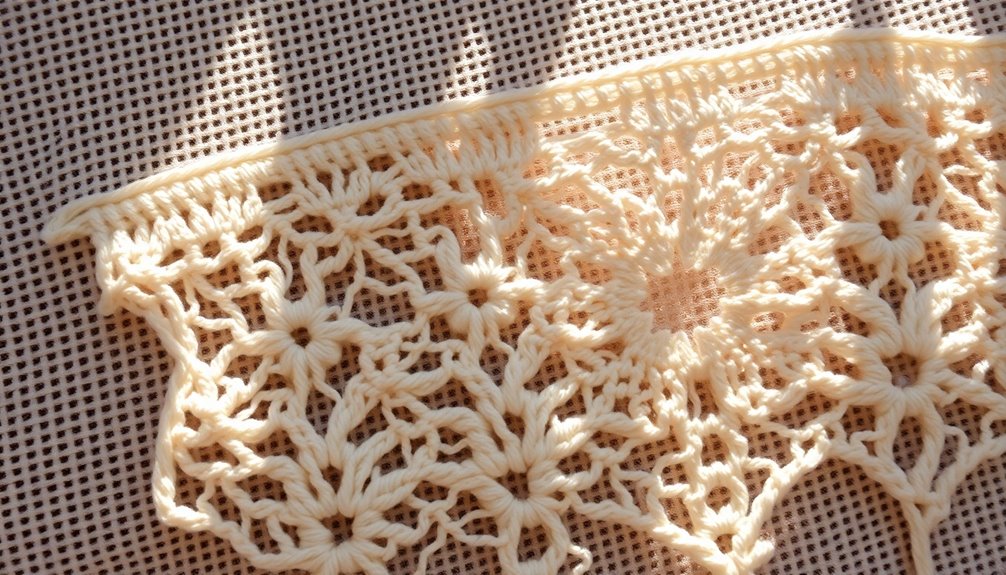
While you mightn't realize it, incorporating the "SK" technique in your crochet can greatly enhance your projects by creating a lacy design element.
By skipping stitches (SK), you introduce intentional gaps that add a beautiful lacy effect to your crochet patterns. This technique is especially effective in patterns like the V-stitch, where it enhances the overall design.
You can strategically place SK to open up space in shawls, summer tops, or any project, making them lighter and airier.
Mastering the SK technique lets you explore greater creativity, allowing you to design intricate motifs and decorative elements that showcase your yarn's characteristics.
Embrace SK to transform your standard crochet into stunning openwork designs!
For Buttonholes

Creating buttonholes in your crochet projects adds both functionality and style. To effectively use "sk" for buttonholes, follow these steps:
- Chain Stitches: Start by chaining the number of stitches specified in your pattern.
- Skip Stitches: Identify which stitch or stitches to skip as per your pattern instructions. This is where "sk" comes into play.
- Work the Remaining Stitches: Complete the row by working into the remaining stitches, creating the buttonhole.
Buttonholes can be customized by adjusting the number of skipped stitches and chains. This flexibility enhances your projects, making them more versatile and user-friendly.
As a Decrease Method
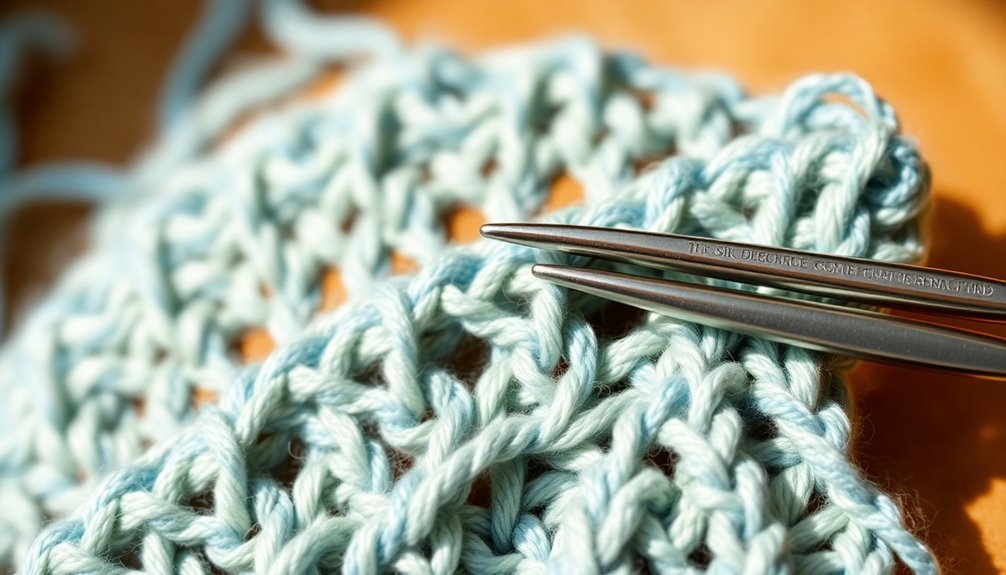
Using "sk" as a decrease method is a practical way to shape your crochet projects, especially when crafting fitted garments. This technique involves skipping specific stitches to reduce your stitch count, creating clean lines and structured designs.
By incorporating "sk," you can effectively shape armholes or curves, ensuring a smooth shift between rows. This prevents bulky areas, maintaining the overall aesthetic of your piece.
Additionally, when you combine the "sk" method with other stitches, it enhances texture and adds visual interest. Properly executing the "sk" decrease method is essential for achieving consistent results, so practice this technique to elevate your crochet skills and create beautifully fitted items.
When Skip Can Be Confusing in Crochet Instructions
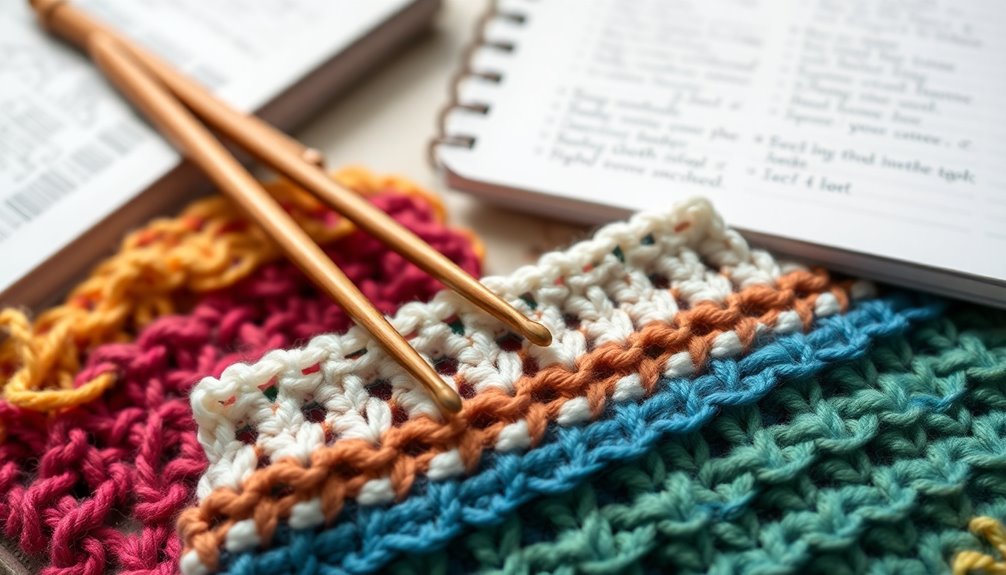
When you're working on complex crochet patterns, skipping stitches can get tricky.
If the instructions aren't clear, you might find yourself confused about which stitches to skip. Using symbols like parentheses or brackets can help clarify the process and keep you on track.
Complex Patterns Challenge Understanding
Crochet patterns can often feel overwhelming, especially when they involve skipping stitches. The term "sk" can lead to confusion in complex designs where the instructions aren't crystal clear.
Here are a few things to keep in mind:
- Check for Clarity: Look for parentheses or brackets that may indicate how many stitches to skip in the crochet pattern.
- Review Instructions: Misprints can throw you off, so double-check the stitch sequence before proceeding.
- Experiment: If you're unsure, don't hesitate to try different skipping techniques to see how they affect your project.
Understanding these aspects helps you grasp what "sk" means, allowing you to navigate intricate patterns with confidence and avoid frustrating mistakes.
Clarifying Instructions With Symbols
Symbols in crochet patterns can considerably clarify complex instructions, especially when skipping stitches is involved. When you see "sk next," it's crucial to understand how it fits within the overall stitch instructions.
Patterns often use parentheses or brackets to group skips and other stitches, making it easier to follow the sequence. Before diving in, take a moment to review the entire pattern to pinpoint where skips occur. This can prevent misinterpretation of the abbreviations used.
If you encounter unclear or misprinted instructions, experimenting with sample swatches can help you grasp the intent behind the skips. This hands-on approach can enrich your understanding of how skipping stitches influences the design and stitch count.
Tips and Tricks for Flawless SK Execution

Mastering the SK technique can elevate your crochet projects, so it's essential to implement a few helpful tips.
Here's how to execute SK in crochet flawlessly:
- Use stitch markers: Mark the stitches you need to skip to maintain accuracy and keep track of your stitch count throughout the project.
- Practice with various yarns: Experiment with different yarn weights and hook sizes to discover what works best for you, ensuring consistent tension and results.
- Follow patterns closely: Always adhere to the pattern to skip the correct number of stitches, preventing misalignment or unintended gaps.
Mastering the SK Technique

Embrace the "SK" technique to transform your crochet projects into stunning creations filled with texture and design. This technique, which involves skipping specified stitches, allows you to craft open spaces and lacy designs effortlessly.
Mastering SK is essential for creating buttonholes and shaping garments, enabling adjustments without adding bulk. To execute SK effectively, use stitch markers to mark the stitches you need to skip, ensuring accuracy.
Experiment with different yarns and hooks to find what feels comfortable for you, enhancing your crocheting proficiency. Remember to regularly check your stitch counts after performing SK to maintain alignment and preserve the integrity of your design.
With practice, you'll achieve a polished final product that showcases your skills beautifully.
Frequently Asked Questions
What Does SK Mean in Crochet?
When you see "SK" in crochet, it means you should skip a stitch or stitches as directed by your pattern.
This technique adds open spaces to your work, creating beautiful lacy effects. It's often used for buttonholes or shaping garments, so understanding it's key for both functionality and aesthetics.
Mastering the "SK" instruction can really enhance your crochet skills and creativity, allowing you to tackle more complex projects with confidence.
How to Sk 1 Crochet?
Imagine creating a delicate lace shawl, where each stitch reveals airy gaps.
To "sk 1," you simply count over one stitch and jump to the next. It's like dancing through your project—don't let that stitch trip you up!
Maintain even tension as you skip; this keeps your work looking polished.
Practice on swatches to feel confident, and soon you'll master this technique, adding beautiful texture to your crochet creations.
What Does SSC Mean in Crochet?
In crochet, "SSC" stands for spike stitch crochet. It involves inserting your hook into a stitch several rows below your current row, creating a long stitch that spikes out from your fabric.
This technique adds texture and dimension to your projects, making it popular for blankets, scarves, and hats.
To master the SSC, you'll need practice to keep your tension consistent and guarantee it aligns well with the surrounding stitches.
What Is the K Symbol in Crochet?
You might think the “K” symbol in crochet is a mysterious code straight from a secret society of crafters, but it’s really quite simple! In fact, the “K” stands for “knit,” which is often used in patterns to indicate a knitting stitch rather than a crochet one. If you’re diving deeper into other terms, you might find yourself wondering, “what does inc mean in crochet? ” This abbreviation stands for “increase,” a crucial technique used to add stitches and expand your project.
Typically, it stands for "knit," particularly in patterns that mix crochet and knitting techniques. Sometimes, it signals a knit stitch or a knitting technique within a crochet pattern.
Always check the pattern's guide, as the meaning can shift based on the designer's intent.
Happy stitching!
Conclusion
Now that you've unraveled the mystery of "SK" in crochet, you're ready to weave it into your projects with confidence. Think of skipping stitches as dancing through your yarn, creating beautiful patterns and textures. Whether you're crafting delicate lace or perfecting buttonholes, mastering this technique adds flair to your work. So, grab your hook, and let your creativity flow—each SK is a step closer to your next crochet masterpiece! Happy stitching!


